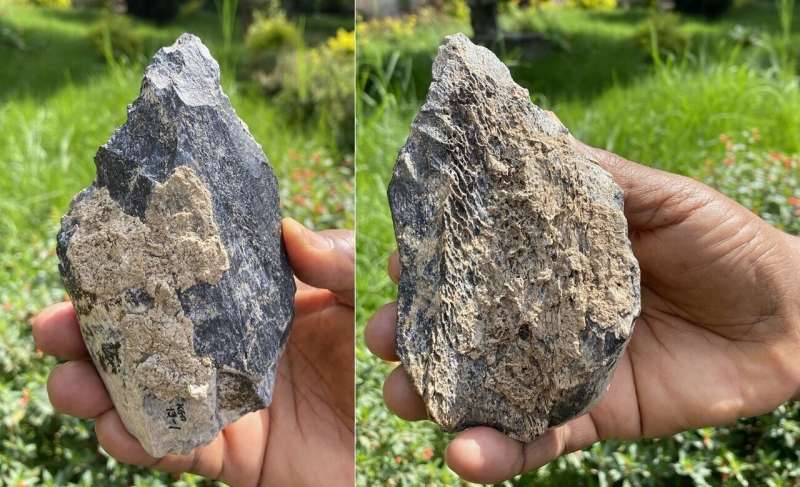July 14, 2020 report
Homo erectus hand ax found in East Africa

A team of researchers from Japan, Hong Kong and Ethiopia has found a hand ax that they believe was made by a possibly direct human ancestor in what is now modern Ethiopia. In their paper published in Proceedings of the National Academy of Sciences, the group describes finding the hand ax, their study of it and what they believe it represents.
In the past, scientists working in Africa have found hand axes made by members of Homo erectus, a possible direct ancestor of humans. In all such cases, the hand axes were made by chipping bits off of stones until the edge became sharp. In this new effort, the researchers have found a similar hand ax, except this time, it was made from bone.
The hand ax was unearthed at a dig site in Ethiopia called Konso-Gardula, a site where previous researchers have found Homo erectus-made hand axes, all of which were made of stone. The location of the hand ax suggested it was approximately 1.4 million years old. It represents just the second bone-based Homo erectus-made hand ax ever found.
Study of the hand ax showed it to have been made from the thigh bone of a hippopotamus. It was roughly 13 centimeters long with an oval shape, and one of its edges had been sharpened using another tool—likely a hard rock. The researchers found that its design was similar to that of hand axes made of stone. Prior research has shown that such hand axes were made by a toolmaker using a single sharp blow to knock off a major part of the new tool edge. The edge would then be honed by repeated chipping with a bone or stone hammer.
The researchers also found evidence that the hand ax had been used—there were quasi-continuous flake scars, polish due to wear, rounding of edges and striae patches. They suggest the hand ax was likely used to butcher animals to make them easier to eat. They also suggest its construction shows that members of Homo erectus were quite skilled in tool making, a sign that they were reasonably intelligent. The researchers were not, however, able to explain why the toolmaker had chosen to use bone instead of the much harder stone, despite the presence of stones to choose from in the area.
More information: Katsuhiro Sano et al. A 1.4-million-year-old bone handaxe from Konso, Ethiopia, shows advanced tool technology in the early Acheulean, Proceedings of the National Academy of Sciences (2020). DOI: 10.1073/pnas.2006370117
Journal information: Proceedings of the National Academy of Sciences
© 2020 Science X Network





















